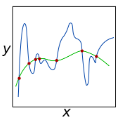In this paper, we proposed a multi-objective approach for the EEG Inverse Problem. This formulation does not need unknown parameters that involve empirical procedures. Due to the combinatorial characteristics of the problem, this alternative included evolutionary strategies to resolve it. The result is a Multi-objective Evolutionary Algorithm based on Anatomical Restrictions (MOEAAR) to estimate distributed solutions. The comparative tests were between this approach and 3 classic methods of regularization: LASSO, Ridge-L and ENET-L. In the experimental phase, regression models were selected to obtain sparse and distributed solutions. The analysis involved simulated data with different signal-to-noise ratio (SNR). The indicators for quality control were Localization Error, Spatial Resolution and Visibility. The MOEAAR evidenced better stability than the classic methods in the reconstruction and localization of the maximum activation. The norm L0 was used to estimate sparse solutions with the evolutionary approach and its results were relevant.
翻译:在本文中,我们为EEG反问题提出了一个多目标方法。这一提法并不需要涉及经验程序的未知参数。由于问题的组合特点,这一备选方法包括解决问题的进化战略。其结果是基于解剖限制(MOEAAR)的多目标进化算法,以估计分布式解决办法。比较测试介于这种方法和三种典型的正规化方法之间:LASSO、Ridge-L和ENET-L。在实验阶段,选择回归模型是为了获得稀少和分布式的解决方案。分析涉及具有不同信号对噪音比率的模拟数据。质量控制指标是地方化错误、空间分辨率和可见度。MOEAAR在最大激活的重建和本地化中,比典型方法更稳定。标准L0用来估计与进化方法有关的稀少的解决方案及其结果。



